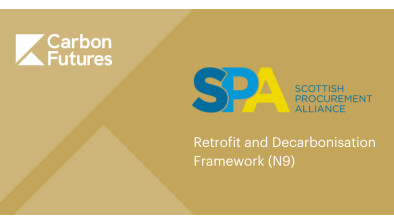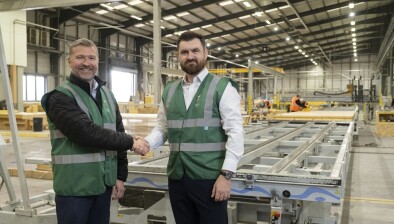CCG Group unveils pioneering ‘Whole-Life Carbon’ research

David Wylie, CCG (Scotland) managing director (left), and Andrew Money, Carbon Futures director
The CCG Group has completed pioneering research into “Whole-Life Carbon,” providing crucial insights into carbon emissions throughout the house building lifecycle, and strategies for reducing them to achieve net zero.
The research aims to help CCG make informed decisions on responsible sourcing of materials, design detailing and construction practice - all focussed on reducing the total carbon footprint, helping to meet future emissions targets and building standards.
Among the most advanced in the UK, the research builds on the company’s applied research into net zero homes which began in 2018.
In partnership with Carbon Futures, an independent consultancy that specialises in building simulation modelling and analysis, the research was structured into three key stages of assessment.
It began with analysing ‘Embodied Carbon’ emissions, which are associated with raw material extraction, manufacturing, transportation, and the construction process to complete a new build home.
The second stage examined ‘Operational Carbon’ emissions from fixed services such as heating, cooling, lighting, pumps, and fans during the home’s occupancy.
Finally, the assessment considered emissions at the home’s end-of-life, including demolition, recycling, and material re-use.
The analysis was modelled on a CCG house type that adopted three different approaches to energy strategy:
- Gas-powered heating;
- Zero-emissions heating via an air-source heat pump;
- Zero-emissions heating via air-source heat pump plus triple-glazing, solar panels, and electric battery storage.
For each approach, the house type retained the same foundation solution and structural composition – using CCG’s off-site manufactured, closed panel ‘iQ’ Timber System for the superstructure and their own windows and doors - as well as the same Mechanical, Electrical, and Plumbing (MEP) services, and materials for the walls, roof, and internal finishes.
The ‘Carbon Life Cycle Assessment’ revealed CCG’s Net Zero Home Build standard is compliant with the widely regarded 2030 LETI (Low Energy Transformation Initiative) Design Guide (2020) embodied carbon targets.
The results also showed the addition of a battery storage unit can lower operational emissions by up to 45%, however, the embodied carbon within current battery composition means emissions are in fact higher over the home’s lifetime.
A final comparison of the CCG Net Zero Home build standard was made with a theorised Passivhaus-accredited version of the same house type.
The results evidenced Whole-Life Carbon emissions for the Passivhaus standard were 25% higher when compared with CCG’s own specification.
David Wylie, managing director of CCG, highlighted the company’s proactive approach: “Since April 1 of this year, all new-build homes applying for a building warrant have been required to use non-fossil fuel (‘non-polluting’) heating systems. The ‘New Build Heat Standard’ was something we anticipated as far back as 2018.
“We recognised early on that to stay ahead of market changes, we would need to invest in and adopt new techniques and technologies, ensuring a seamless transition for both our business, our customers and the homeowner.
“This forward-looking approach will also apply to Whole-Life Carbon, and the results show just how far CCG has already come in reducing emissions. Our construction methods and the products we create naturally help to lower emissions due to the materials we use and where they are sourced from, and reduced vehicle movements at every stage of the project delivery process.
“This deeper understanding places us ahead of the industry and will only add value in the long term as building standards evolve and we continue our net zero transition. However, the potential introduction of the Scottish Passivhaus Equivalent is particularly significant.
“While CCG has assessed the Carbon Lifecycle of housing, the recently concluded Energy Standards Review consultation on a proposed Scottish Passivhaus standard does not – it only considers Operational Carbon.
“Our evidence shows that total emissions over the lifetime of a Passivhaus build are higher, which suggests that if carbon reduction truly drives legislative change, a Whole-Life Carbon approach is essential to genuinely address net zero.”
The research is one most advanced studies of its kind in the UK and builds on the introduction of the CCG Net Zero Home build standard which has been used by the firm in Scotland since 2021.
The Net Zero Home is a mass-market solution designed to address the operational energy performance of housing.
It utilises a mix of an enhanced building fabric, using CCG’s own manufactured timber system to minimise heat loss, and zero direct emissions heating solutions to future-proof homes and push performance towards operational net zero.
This standard is currently supporting the delivery of over 800 mixed-tenure homes across four Scottish local authorities, including a 444-home project in Edinburgh which is the largest of its kind anywhere in the country.
Development of the Net Zero Home standard and the Whole-Life Carbon Assessment was undertaken in partnership with Carbon Futures.
Andrew Money, director of Carbon Futures, explains the research findings. He said: “Carbon Futures were delighted to be appointed by CCG to support this project. Our work has spanned many years and is the culmination of numerous key packages of research and development, including U-value and thermal bridging analysis, operational energy analysis, and Whole-Life / Embodied Carbon assessments.
“This project really demonstrates the importance of collaboration and highlights the positive impact it can have on the wider construction industry. As we strive to reduce the energy consumption in our homes and build to higher standards, we must also address the underlying emissions from material sourcing, transportation, and manufacturing processes. Only by considering and mitigating these factors can we make meaningful progress towards a net zero future and lessen our impact on the environment.”























